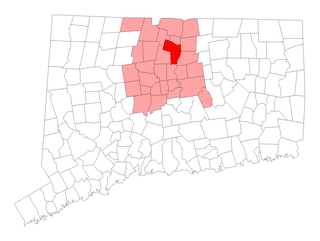
Windsor is a town in Hartford County, Connecticut, United States, and was the first English settlement in the state. It lies on the northern border of Connecticut's capital, Hartford. The population of Windsor was 29,492 at the 2020 census.

The Oliver Ellsworth Homestead, also known as Elmwood, is a historic house museum at 788 Palisado Avenue in Windsor, Connecticut. Built in 1781, it was the home of the American lawyer and politician Oliver Ellsworth until his death in 1807, and was designated a National Historic Landmark because of this association. Ellsworth (1745–1807) helped draft the United States Constitution, served as the third Chief Justice of the United States, and was a United States Senator from Connecticut. The house is owned and maintained and operated as a museum by the Connecticut Daughters of the American Revolution, and is open for tours upon request.

The Hezekiah Chaffee House is a historic house museum on Meadow Lane in Windsor, Connecticut. Built about 1765, it is one of Windsor's largest and most elaborate Georgian brick houses. The house was listed on the National Register of Historic Places in 1972, and is a contributing property to the Palisado Avenue Historic District, listed in 1987. It is owned and operated by the Windsor Historic Society, which offers tours on a year-round basis.
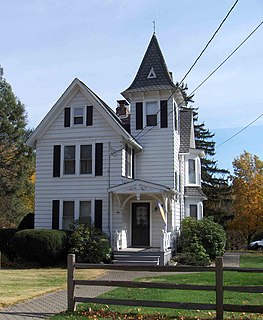
Marion is a neighborhood in the town of Southington in Hartford County, Connecticut, United States. It is generally the area in the vicinity of the intersection of Route 322 and Marion Avenue just north of the Cheshire town line.
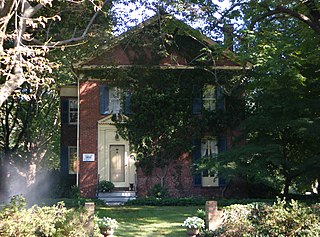
The First Church Parsonage is a historic parsonage house at 160 Palisado Avenue in Windsor, Connecticut. Built in 1852 for the new minister of the First Congregational Church, it is a well-preserved example of transitional Greek Revival-Italianate architecture in brick. The house was listed on the National Register of Historic Places in 1988.
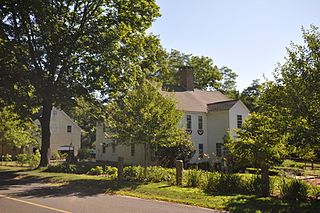
The Peck Tavern is a historic tavern at 1 Sill Lane in Old Lyme, Connecticut. With a construction history that may date to the 17th century, it is one of the town's oldest buildings, and was an important local meeting place in the 18th century. The building was listed on the National Register of Historic Places on April 12, 1982.

Hansen's Annex is a historic house on Main Street in Center Sandwich, New Hampshire, United States. Built about 1839, it is one of a small number of Greek Revival buildings to survive, out of many that once graced the town. It has seen use as a single-family residence, tavern, and boarding house. It was listed on the National Register of Historic Places, and included in the Center Sandwich Historic District, in 1983.

The Aiken Stand Complex is a historic pair of buildings at the junction of Royalton Turnpike and Sayer Road in rural Barnard, Vermont. Built c. 1805 and 1835, they were the centerpiece of a small village that flourished in the first half of the 19th century, when the Turnpike was the principal north–south route through the region. The buildings were listed on the National Register of Historic Places in 1983.

The Giles Barber House is a historic house at 411-413 Windsor Avenue in Windsor, Connecticut. Built about 1825, it is a well-preserved local example of a transitional Federal-Greek Revival brick house. It was listed on the National Register of Historic Places in 1988.

The Broad Street Green Historic District encompasses the historic late-19th century town center of Windsor, Connecticut. It is centered around the Broad Street Green, a public park extending on the east side of Broad Street between Union and Batchelder Streets, and includes a diversity of architecture spanning much of the town's long history. It was listed on the National Register of Historic Places in 1999.

The Taylor Chapman House is a historic house at 407 Palisado Avenue in Windsor, Connecticut. Built in 1764, it is a well-preserved example of Georgian architecture executed in brick. It was listed on the National Register of Historic Places in 1988.

The Horace H. Ellsworth House is a historic house at 316 Palisado Avenue in Windsor, Connecticut. It was built in 1872 for one of Windsor's leading citizens, and is a fine example of Italianate architecture executed in brick. It was listed on the National Register of Historic Places in 1988.
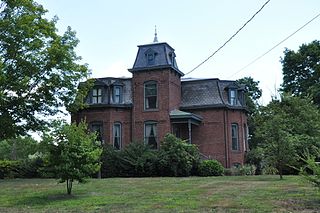
736 Palisado Avenue is one of a small number of Second Empire houses in Windsor, Connecticut. Built about 1865, it is a distinctive surviving example of the style in brick, with a mansard roof and turret. It was listed on the National Register of Historic Places in 1988.

The Hastings Hill Historic District encompasses a rural crossroads settlement of the early 19th century at the junction of Spruce Street, Hill Street, and Russell Avenue in Suffield, Connecticut. The area includes well-preserved examples of 18th and 18th-century domestic architecture, as well as the 1842 First Baptist Church and a district schoolhouse. It was listed on the National Register of Historic Places in 1979.

The Henry Magill House is a historic house at 390 Palisado Avenue in Windsor, Connecticut. Built in 1861, it is a well-preserved and locally rare example of Second Empire architecture executed in brick. It was listed on the National Register of Historic Places in 1988.

The Patrick Murphy House is a historic house at 345 Palisado Avenue in Windsor, Connecticut. Built about 1873, it is a good example of Italianate architecture executed in brick. It was listed on the National Register of Historic Places in 1988.

The Palisado Avenue Historic District encompasses a predominantly residential streetscape in northeastern Windsor, Connecticut. Extending along Palisado Avenue between the Farmington River and Bissell Ferry Road, it is a basically 18th-century street view, populated mainly with houses from the 18th to the 20th centuries. The district was listed on the National Register of Historic Places in 1987.
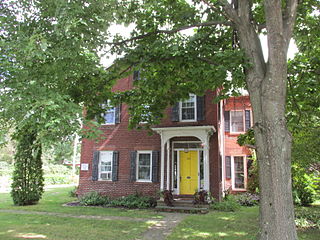
The Sophia Sweetland House is a historic house at 458 Palisado Avenue in Windsor, Connecticut. Built about 1845, it is a good local example of transitional Greek Revival-Italianate architecture executed in brick. It was listed on the National Register of Historic Places in 1988.
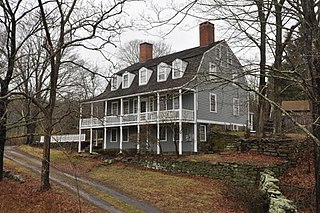
The Medad Stone Tavern is a historic house museum at 191 Three Mile Course in Guilford, Connecticut. Built in 1803 but never actually used as a tavern, it is well-preserved example of early 19th-century Federal period architecture. It is now maintained as a museum by a local historical society. It was listed on the National Register of Historic Places in 2009.

The Rising Sun Tavern is a historic house and former public accommodation on Old Tavern Road in North Haven, Connecticut. Probably built around 1760, it is a well-preserved example of an 18th-century tavern house, serving in that role into the mid-19th century. Now a private residence, it was listed on the National Register of Historic Places in 1979.






















